A interesting sushi roll presentation I picked up from a great cookbook “Dinner With Friends” is the square sushi. It was deceptively easy to make and adding the wasabi ginger rose on top create a great cohesive image.
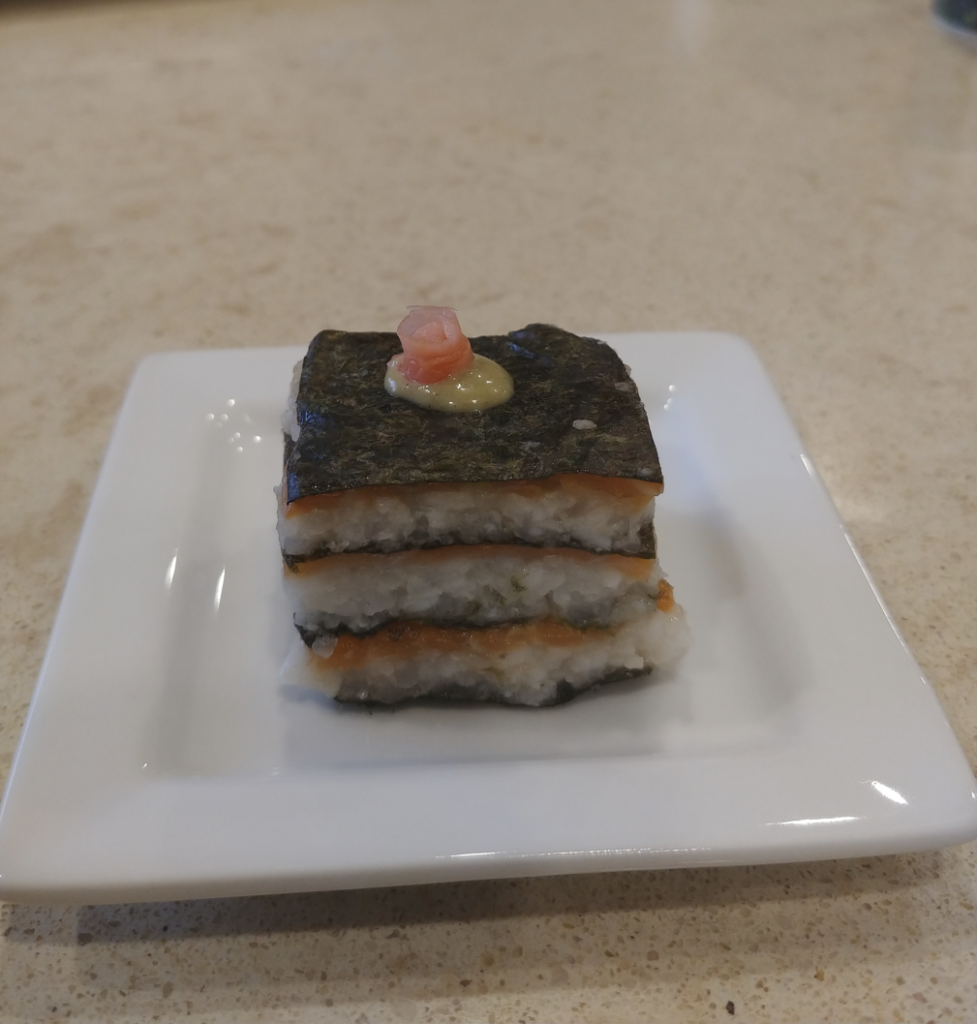
General
A interesting sushi roll presentation I picked up from a great cookbook “Dinner With Friends” is the square sushi. It was deceptively easy to make and adding the wasabi ginger rose on top create a great cohesive image.

A go to classic is a grilled trout fillet on a bed of risotto.There is nothing to note and no real difficulties but a tomato rose garnish with a bit of dill makes this a visually appealing dish.
We had 2 great days at Mont Tremblant. One with clear skies and beautiful views and the other with perfect snowfall and skiing conditions, a perfect weekend combination.

This will be a quick overview of my current homelab after some of the recent consolidation and upgrades.
To start off I have a custom (handmade) server rack made to hold all of the equipment. I use trays to hold auxiliary equipment such as keyboards, spare disk for quick replacement and other hardware. Plan is to move my desktop to one of these shelves on my next upgrade.
I have a 1500VA UPS https://www.apc.com/us/en/product/BX1500M/apc-back-ups-1500-compact-tower-1500va-120v-avr-lcd-10-nema-outlets-5-surge/ that meets my needs and covers any power disruptions. I have a RJ45 data-cable connected to my server to auto email on any outages and initiate shutdowns if needed.
For my main workhorse I have a DELL R530 server with 8 3.5 inch bays and a 10G nic. This handles a bulk of my file store, database and processing needs. I run Proxmox as my host and various debain based distributions on my VMs.
Lastly for my switch I have a Mikrotik CSS326-24G-2S+ which has 2 SFP+ ports that can handle 10Gbps which I use for my server and workstation. For the server I use a cat 6 patch cable and for my workstation I use a fibre optic cable as cat 6 can’t handle the distance. The remaining 24 1Gbps ports are used for various devices.

I have recently installed a CSS326-24G-2S+ Mikrotik switch. The problem is that it is a passively cooled switch and runs at 68F in my setup causing intermittent network stutters. To combat this I have added 2 actively cooled fans to the switch. After some poking around with a multi meter I found a stable 24V source beside the power supply. I think this is a common motherboard and the source is used on other models but not on mine.
I added a couple of ~1W fans off of this 24v source to improve cooling. 1 fan is to exhaust hot air and the other is a blower style fan directed at the 2 SFP+ ports that are the most prone to overheating.
After this modification I was able to drop the temperature down to 36C. A simple 2W solution to a comical problem.

Microsoft does not allow common individual users to use power BI by requiring the use of either work or school email addresses (https://docs.microsoft.com/en-us/power-bi/fundamentals/service-self-service-signup-for-power-bi). I even tried to use my proton mail account and it didn’t accept it so its blacklist is fairly deep.
One workaround I found is that because I have my own domain (adam-s.ca) I can effectively setup my own custom email address. On my domains service I setup an email forward to pass on all emails sent to xxxxx.adam-s.ca and pass them onto my gmail account. This way I am not paying for a email server and still have access to professional emails ([email protected] :D). This is enough to setup a free Power BI account and have the ability to publish great dashboards.

I wanted to share some of my person dashboards that I run off of Power BI.
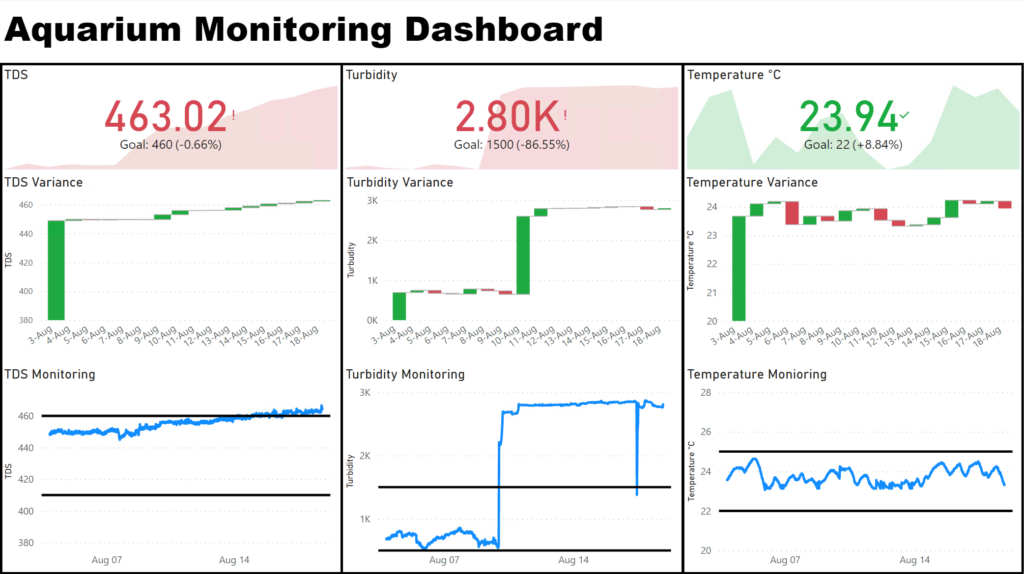
The first one is my aquarium monitoring dashboard which I use to monitor my KPI. Now its been a while since I did a water change so you can see my TDS is out of spec and I recently moved my turbidity probe to a more appropriate location to properly manage the tank. I have 3 quick cards to see if I am green or red and then further charts to show daily variances and the time series trend at the bottom. I have some alerts that go out when I go out of tolerance but as can be clearly seen I don’t necessarily change my water immediately. (Before anyone freaks out, I have a heavily planted tank so I have a healthy equilibrium that allows me to do infrequent water changes).
Next I have my temperature monitoring dashboard that I use to track 3 main temperatures: my room temperature, my sun-room temperature (and by extension my outside temperature) and my server rack temperature. There is not much to note but I do use the server rack temperature to ensure good operation of equipment. I don’t want to run my server to hot as that my cause early device failure.
Lastly I have my power monitoring dashboard, where I track my desktop computer, server rack and fridge temperature. I track my desktop power usage to understand costs associate with use and to track GPU mining profitability. Server rack power as an important one as well as server hardware is known to be a big power draw. I spent a fair bit of time optimizing power usage and this dashboard was important in tracking those changes.
Overall I have much more work related dashboards but these are the ones I run on my personal Power BI workspace.
Follow up on my previous 10G network install https://adam-s.ca/wp-admin/post.php?post=543&action=edit.
I included a cost breakdown of my 10G networking journey with the total cost being ~$660. There are certain costs that aren’t fully accurate as the Dell server was total 300$ not just the NIC but I included it for full transparency.
| Item | Cost |
| Server Dell R530 with 10G 2 port NIC | $300 |
| Intel Fiber SFP+ Module | $24.99 |
| Mikrotik Fiber SFP+ Module | $20.99 |
| Fiber Optic Cable 10M LC to LC | $20.99 |
| Mikrotik RJ45 SFP+ Module | $69.99 |
| Mikrotik 10G Switch CSS326-24G-2S+RM | $145.01 |
| Intel X520 10G SFP+ NIC | $79.01 |
| TOTAL | $660.98 |
If I had to go back and change I found that the RJ45 SFP+ modules run hot and would swap it with a full DAC cable but I went with it because that is what I could do with the NIC I had in the server. Additionally I could have gone cheaper on the connection to my workstation but I felt it would be cool to do a fiber optic run with LC cables. I did pay a premium for this but now I can flex and say that my network connection is as fast as light ;).
I have recently updated my home network backbone to 10G but my ISP hasn’t gotten the message and still offers only max 300Mbps -_-.
With the recent acquisition of my new Dell R530 server and it’s accompanying 10G nic I decided it was time to upgrade my homelab backbone to 10G. The process was relatively painless and not too expensive. I purchased Intel 10G nics for the remaining computers and a Mikrotik CSS326-24G-2S+ switch to handle the 10G traffic. On top of this (and mainly for the bragging rights) I used fibre optics to connect my main workstation computer but user cat 6 RJ45 for the server.
When stress testing with Iperf3 I was able to achieve 7.41Gbps throughput but finding some stuttering. After investigating I am having some overheating concerns so I will be Jerry-rigging a fan for better cooling.
That being said I am still getting good real work performance with stable 571MBps file uploads and downloads from my NAS but I am seeing some PCIe Gen 3 limitations with my nvme drives that I will try to address on my next upgrade.

Overall this was a very successful upgrade so far and though there are still some open items and lessons learned it has drastically improved usability of the network and system backups no longer bring my network to a halt. Now if only my ISP would get the message and start offering fibre in my area.

I have never liked adding dirty/cloudy ice to a great cocktail but the cost of clear ice has always been a bit prohibitive for me. One method of making clear ice at home is to use a cooler. Filling a cooler ~75% with water and then putting it uncovered in a freezer for ~14 hours creates a crystal clear layer of ice while the dissolved gasses remain in the water layer below. The 1-2 inch sheet of clear ice can then be removed and cut down to size.

